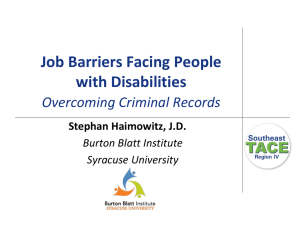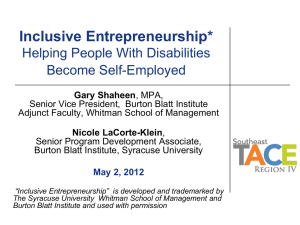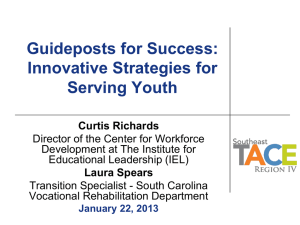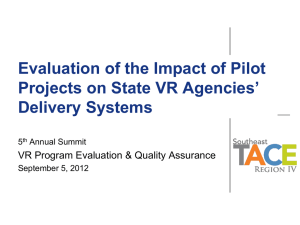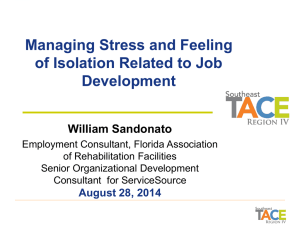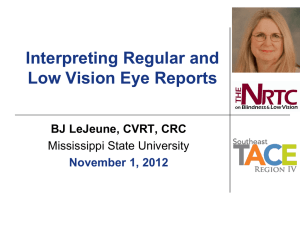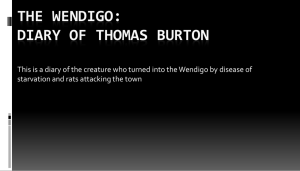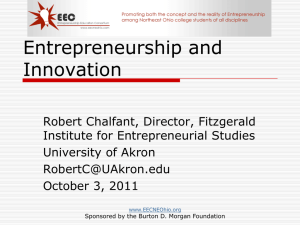PPT - Southeast TACE
advertisement
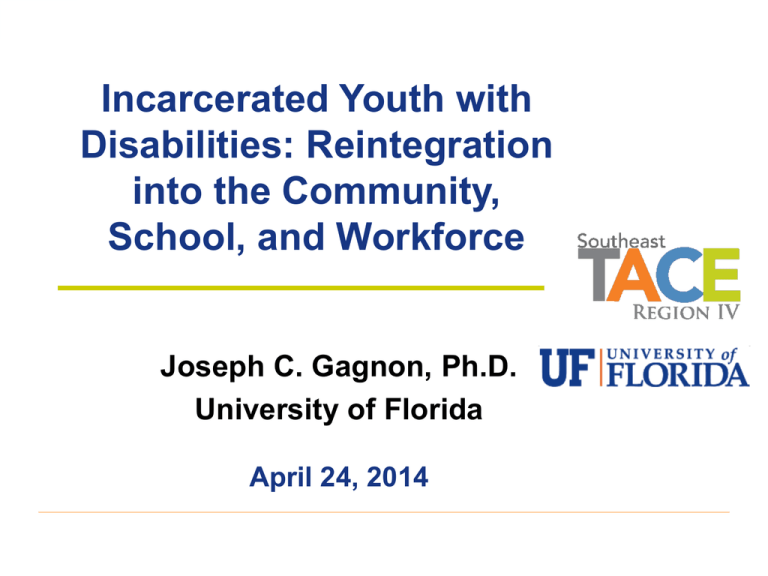
Incarcerated Youth with Disabilities: Reintegration into the Community, School, and Workforce Joseph C. Gagnon, Ph.D. University of Florida April 24, 2014 2 Agenda • Youth in Juvenile Corrections: Curriculum and • • Characteristics Guideposts for Success Promising Practices for Practitioners Throughout the Juvenile Justice Process TACE Center: Region IV, a project of the Burton Blatt Institute. Funded by RSA Grant # H264A080021. © 2014 Marc Gold & Associates 3 Need to Understand Characteristics • An understanding of the unique characteristics of youth involved in the juvenile justice system is critical to developing more effective policies, programs, and service systems (Wagner, Kutash, Duchnowski, Epstein, & Sumi, 2005) • Balanced consideration of community protection, offender accountability, and competency development are key to creating a coordinated system that truly operates in both the best interest of the child and the community (Harp, 2002) TACE Center: Region IV, a project of the Burton Blatt Institute. Funded by RSA Grant # H264A080021. © 2014 Marc Gold & Associates 4 Curriculum • Appropriate educational services for incarcerated youth are an important element of successful transition into society (Foley, 2001; Nelson, Leone, & Rutherford, 2004) • No Child Left Behind Act (2002): Provide all youth with a “fair, equal, and significant opportunity to obtain a high-quality education” (Sec. 101) TACE Center: Region IV, a project of the Burton Blatt Institute. Funded by RSA Grant # H264A080021. © 2014 Marc Gold & Associates 5 Curriculum • IDEA (2004) requires that services be designed and delivered to youth with disabilities to provide access to and progress in the general education curriculum (Cortiella, 2006) • The assumption: Providing all students with access to the general education curriculum will prepare students for life after exiting school (National Center on Secondary Education and Transition, 2004) TACE Center: Region IV, a project of the Burton Blatt Institute. Funded by RSA Grant # H264A080021. © 2014 Marc Gold & Associates 6 Curriculum • Many experts consider that education for youth in JC schools should include access to the general education curriculum, as well as pre-vocational and vocational training, paid work experience, and General Educational Development (GED) test preparation (Carter, Lane, Pierson, & Glasser, 2006; Lane & Carter, 2006; Nelson et al., 2004; Rutherford, Quinn, Leone, Garfinkel, & Nelson, 2002) TACE Center: Region IV, a project of the Burton Blatt Institute. Funded by RSA Grant # H264A080021. © 2014 Marc Gold & Associates Characteristics of Incarcerated Youth • 38.15% of students are in special education compared to • • 12% in public school. Most of these students have emotional disturbance or learning disabilities (Gagnon, Barber, Van Loan, & Leone, 2009; Stizek, Pittsonberger, Riordan, Lyter, & Orlofsky, 2007) Typically have few academic credits and low grade point averages (Major, Chester, McEntire, Waldo, & Blomberg, 2002) Rarely return to high school, stay in school, and earn a diploma upon exit from a JC school (Griller-Clark, Rutherford, & Quinn, 2004). TACE Center: Region IV, a project of the Burton Blatt Institute. Funded by RSA Grant # H264A080021. © 2014 Marc Gold & Associates 7 Characteristics of Incarcerated Youth (cont.) • Excluding conduct disorder, nearly 2/3 of males and 3/4 • • of females had one or more psychiatric disorders (Teplin et al., 2002) 40-50% of youth with ED were neglected, physically/sexually/emotionally abused (Mattison, Spitznagel, & Felix, 1998; Oseroff, Oseroff, Westling, & Gessner, 1999) Of confined youth, about 1/2 of males and almost 1/2 of females have a substance use disorder (Teplin et al., 2002) TACE Center: Region IV, a project of the Burton Blatt Institute. Funded by RSA Grant # H264A080021. © 2014 Marc Gold & Associates 8 9 The Guideposts for Success 1. School-Based Preparatory Experiences • Career Preparation & Work-Based Experiences • Youth Development & Leadership • Connecting Activities • Family Involvement and Supports TACE Center: Region IV, a project of the Burton Blatt Institute. Funded by RSA Grant # H264A080021. © 2014 Marc Gold & Associates 10 School-Based Preparatory Experiences • • • • • • Specific Needs: Highly qualified teachers Curriculum aligned with state and local standards Educational options Transferable credits Meeting federal accountability requirements NCLB, IDEA Collaboration among professionals across disciplines TACE Center: Region IV, a project of the Burton Blatt Institute. Funded by RSA Grant # H264A080021. © 2014 Marc Gold & Associates 11 Career Preparation & Work Place Experiences Examples • North Carolina Program • Graduated release program • Advocate/job development specialist Specific Needs: • Comprehensive vocational programming • Collaboration among education, corrections, community organizations, employers • Development of career pathways • Instruction in work-related skills • Work-based experiences TACE Center: Region IV, a project of the Burton Blatt Institute. Funded by RSA Grant # H264A080021. © 2014 Marc Gold & Associates 12 Youth Development & Leadership • • Examples • Project SUPPORT • Project Parole SUPPORT • Local employers serving as mentors • • • • Specific Needs: Highly individualized transition plan with youth input Transition support that recognizes unique needs of youth in corrections Instruction on laws, rights, consequences throughout process Education on risk-taking behaviors/consequences Self-empowerment activities Mentoring opportunities TACE Center: Region IV, a project of the Burton Blatt Institute. Funded by RSA Grant # H264A080021. © 2014 Marc Gold & Associates 13 Connecting Activities Examples • Cross-system professional development • Comprehensive transition policies in state law (VA) • Exit document (Passport) • • • Specific Needs: Collaboration among families, mental health service providers, educators, youth development professionals, probation officers Clear delineation of roles On-going communication Systemic responses to transitioning youth Assistance in addressing sensitive issues TACE Center: Region IV, a project of the Burton Blatt Institute. Funded by RSA Grant # H264A080021. © 2014 Marc Gold & Associates 14 Family Supports & Involvement • Examples • Multi-systemic Therapy • Family-focused mental health treatment • Specific Needs: Well-informed parent involvement is critical at all stages of juvenile justice process Advocacy Information-sharing Prevention and rehabilitation Supports for parents TACE Center: Region IV, a project of the Burton Blatt Institute. Funded by RSA Grant # H264A080021. © 2014 Marc Gold & Associates Effectively Treating and Rehabilitating Juvenile Offenders and Preventing Recidivism Requires a model that • Is comprehensive, community-based, and integrates Prevention programming A continuum of pre-trial and sentencing placement options and sanctions Aftercare programs (Zavlek, 2005) • Coordinates services through collaboration across Social service Child welfare Mental health Special education Workforce development Community programs TACE Center: Region IV, a project of the Burton Blatt Institute. Funded by RSA Grant # H264A080021. © 2014 Marc Gold & Associates 15 Promising Practices for Practitioners Throughout the Juvenile Justice Process Prevention and Early Intervention U.S. Dept. of Justice’s Office of Juvenile Justice and Delinquency Prevention (OJJDP) has indicated that most unsuccessful juvenile delinquency efforts fail because of their negative approach Further, they suggest that “successful delinquency prevention strategies must be positive in orientation and comprehensive in scope” (OJJDP, 2000) TACE Center: Region IV, a project of the Burton Blatt Institute. Funded by RSA Grant # H264A080021. © 2014 Marc Gold & Associates 16 Promising Practices for Practitioners Throughout the Juvenile Justice Process Prevention and Early Intervention: Positive Behavior Intervention and Support (PBIS) PBIS, a multi-tiered model that promotes pro-social skills in youth with and without disabilities, is an effective approach to problem behavior in schools (Nelson, Sugai, & Smith, 2005) TACE Center: Region IV, a project of the Burton Blatt Institute. Funded by RSA Grant # H264A080021. © 2014 Marc Gold & Associates 17 Promising Practices for Practitioners Throughout the Juvenile Justice Process Prevention and Early Intervention: Positive Behavior Intervention and Support (PBIS) Seven Key Components include: 1. An agreed upon and common approach to discipline 2. A positive statement of purpose 3. A small number of positively stated expectations for all students and staff 4. Procedures for teaching these expectations 5. A continuum of procedures for encouraging displays and maintenance of these expectations 6. A continuum of procedures for discouraging displays of ruleviolating behavior 7. Procedures for monitoring and evaluating the effectiveness of the discipline system on a regular basis TACE Center: Region IV, a project of the Burton Blatt Institute. Funded by RSA Grant # H264A080021. © 2014 Marc Gold & Associates 18 Promising Practices for Practitioners Throughout the Juvenile Justice Process Prevention and Early Intervention: Jobs for America’s Graduates (JAG) JAG model includes three program types: 1. School-to-career program for high school seniors 2. Multi-year dropout prevention for grades 9-12 3. Dropout recovery program that targets dropouts and youth in alternative school settings The JAG model is comprised of several components including: (a) classroom instruction from a trained career specialist; (b) employability skills; (c) adult mentoring, advisement, and support; (d) summer employment training; (e) student-led leadership groups; (f) job and postsecondary education placement; (g) follow-up services; (h) accountability system, and others. TACE Center: Region IV, a project of the Burton Blatt Institute. Funded by RSA Grant # H264A080021. © 2014 Marc Gold & Associates 19 Promising Practices for Practitioners Throughout the Juvenile Justice Process Prevention and Early Intervention: Jobs for America’s Graduates (JAG) In 2004, the graduation/GED rate of participants was 90.9 percent and the postsecondary enrollment rate was 41.2%. (Jobs for America’s Graduates, 2005) Similarly, in 2005 graduation rates for students with disabilities and ED were 85.4% and 81.5%, postsecondary enrollment rates for students with disabilities and ED were 54.3% and 40.9%, respectively (Jobs for America’s Graduates, 2007) TACE Center: Region IV, a project of the Burton Blatt Institute. Funded by RSA Grant # H264A080021. © 2014 Marc Gold & Associates 20 21 Promising Practices: Diversion “An attempt to divert, or channel out, youthful offenders from the juvenile justice system” (Bynum & Thompson, 1996) Alternatives to secure care facilities are important to consider for nonviolent youthful offenders, those with a small likelihood of reoffending, and those likely to attend mandatory meetings. Community based treatments and programs for youth in JJS are generally more effective than incarceration or residential placement in reducing recidivism, even for serious and violent juvenile offenders (Lipsey, Wilson, & Cothern, 2000) Maintaining youth in the community with appropriate supports (e.g., family and individual counseling, school-based interventions, behavioral and social skill interventions) will allow them to continue to work toward post-school selfsufficiency. TACE Center: Region IV, a project of the Burton Blatt Institute. Funded by RSA Grant # H264A080021. © 2014 Marc Gold & Associates Promising Practices: Diversion Programs Some states are developing a more rehabilitative than confinement model for youthful offenders. For non-institutionalized juvenile offenders, certain variables such as increased length of treatment (e.g., interpersonal skills training, individual counseling, behavioral programs) have a significant positive effect on recidivism (Lipsey, Wilson, & Cothern, 2000) TACE Center: Region IV, a project of the Burton Blatt Institute. Funded by RSA Grant # H264A080021. © 2014 Marc Gold & Associates 22 23 Diversion Programs: Examples • Missouri has made a commitment to treatment of youth in small (33 or fewer beds) facilities (Mendel, 2001) • California Youth Authority: Small scale residential facilities (rather than training schools) Extensive 24-hour therapy Quality education programs Heavy family outreach/counseling Well qualified, highly-trained staff Extensive, non-residential programming and aftercare support TACE Center: Region IV, a project of the Burton Blatt Institute. Funded by RSA Grant # H264A080021. © 2014 Marc Gold & Associates 24 Diversion Programs: Family Focused Family-focused treatments, often including components such as cognitive-behavior therapy and medication management, are also effective in assisting non-confined youth (Hoagwood et al., 2001) Strategic family therapy “provides families with tools to overcome individual and family risk factors through focused intervention to improve maladaptive patterns of family interaction and skill-building strategies to strengthen families” (Center for Family Studies, 2002) TACE Center: Region IV, a project of the Burton Blatt Institute. Funded by RSA Grant # H264A080021. © 2014 Marc Gold & Associates 25 Diversion Programs: Teen Courts Approximately 1,109 teen courts currently in existence in U.S. (National Youth Court Center, 2006) Typically an option for youth under 16, having no prior arrest record, and charged with a less serious crime, teen courts provide a system of graduated sanctions via a peer jury, including those that go beyond punishments and include: (a) community service, (b) apology letters, (c) drug/alcohol classes, (d) restitution, and (e) service in future teen court cases Youth may be diverted to teen court at several points in the juvenile justice process including via law enforcement/non-law enforcement referral, intake, via the prosecutor, or as an informal disposition from the court (Butts & Buck, 2000) TACE Center: Region IV, a project of the Burton Blatt Institute. Funded by RSA Grant # H264A080021. © 2014 Marc Gold & Associates 26 Diversion Programs: Teen Courts Teen courts show promise for Decreasing youth recidivism and providing additional benefits, including Youth satisfaction toward the program, More positive attitudes concerning procedural justice and authority, and A greater knowledge of the legal system. However, additional high quality research is needed to identify critical features of effective programs, factors/barriers of program success, types of sanctions that are most effective, and strategies for youth who do not comply with sanctions. TACE Center: Region IV, a project of the Burton Blatt Institute. Funded by RSA Grant # H264A080021. © 2014 Marc Gold & Associates Mental Health and Substance Abuse Treatment for Non-Institutionalized Juveniles Multisystemic Therapy (MST) is a treatment for juvenile offenders that uses a combination of empirically-based treatments (e.g., cognitive behavior therapy, behavioral parent training, functional family therapy) to address multiple variables that have been shown to be factors in juvenile behavior. (Coalition for Evidence-Based Policy, 2006) MST is provided at the youth’s home and community locations and the therapist is available at all times during the intervention TACE Center: Region IV, a project of the Burton Blatt Institute. Funded by RSA Grant # H264A080021. © 2014 Marc Gold & Associates 27 Mental Health and Substance Abuse Treatment for Non-Institutionalized Juveniles (cont.) Three key steps for implementation of MST: • Therapist interviews the youth, family members, friends, and caring adults to identify problem behaviors and possible causes; • Strengths of the youth and supporting people are identified to assist in addressing problem behaviors; • Therapist and youth set goals for the treatment. Review of MST research indicated consistent positive effects for youth with regard to re-arrest, out of home placement, and drug use. Additionally, treatment effects were maintained over time. Cost benefit analyses indicate that MST is associated with equivalent or better outcomes and costs than hospitalization. (Burns, et al., 2000; Sheidow, et al., 2004) TACE Center: Region IV, a project of the Burton Blatt Institute. Funded by RSA Grant # H264A080021. © 2014 Marc Gold & Associates 28 Intervention for Institutionalized Juveniles: Academic One of the most promising research-based options for approaching student learning and teacher professional development is the Strategic Instruction Model (SIM) Two types of interventions are promoted by the SIM model. First, teacher focused interventions that utilize content enhancement are designed to assist teachers in preparing, adapting, and presenting material. Second, student focused interventions provide learning strategies in areas such as reading, studying, interacting with others, and remembering information. Teacher collaboration or teaming is also supported by KUCRL. For more information on the SIM model, please visit http://kucrl.org/ TACE Center: Region IV, a project of the Burton Blatt Institute. Funded by RSA Grant # H264A080021. © 2014 Marc Gold & Associates 29 Intervention for Institutionalized Juveniles: Career & Technical Education Youth completing either vocational training or a GED program while confined are twice as likely to be employed six months after release (Black et al., 1996) Example of a well-developed career-technical education program: North Carolina’s Department of Juvenile Justice and Delinquency Prevention TACE Center: Region IV, a project of the Burton Blatt Institute. Funded by RSA Grant # H264A080021. © 2014 Marc Gold & Associates 30 Intervention for Institutionalized Juveniles: Career & Technical Education A few characteristics: VoCATS - competency based, computer supported system encompassing course and lesson planning, assessment items as well as aggregated and disaggregated reports of students, classes, teachers, schools, and LEAs. Pathways - youth are provided a choice of ten career pathways (e.g., business technologies, health sciences, industrial technologies), and are able to identify a specific career area that is accompanied by a map indicating necessary coursework, work-based learning opportunities, postsecondary options, and possible career options. Youth Apprenticeships - Clear, established plan for apprenticeships (may need to be modified for the unique educational and security attributes of juvenile correctional schools) TACE Center: Region IV, a project of the Burton Blatt Institute. Funded by RSA Grant # H264A080021. © 2014 Marc Gold & Associates 31 Intervention for Institutionalized Juveniles: Behavioral Intervention Attitude held by many in corrections is that confinement should not be a positive place where appropriate behaviors are reinforced (Nelson, Sugai, & Smith, 2005) Positive Behavioral Interventions and Supports PBIS approach provides convincing alternative to the argument for a solely punitive behavioral approach: Illinois Youth Center (IYC) implemented PBIS at the Harrisburg boys’ prison in 2001; minor and major infractions at the school have declined, and fights declined from 32 per month to zero in three years Iowa Juvenile Home (IJH) implemented PBIS model as well; this has led to a reduction in restraint and seclusion by 73 percent and the avg. rate of disciplinary removals reduced by 50 percent TACE Center: Region IV, a project of the Burton Blatt Institute. Funded by RSA Grant # H264A080021. © 2014 Marc Gold & Associates 32 Intervention for Institutionalized Juveniles: Mental Health Some evidence exists suggesting the following intervention strategies reduce recidivism and other variables leading to personal and societal costs caused in part by mental health problems: • Counseling, including components of anger management, social skills training, and career training • Substance abuse treatment including relapse prevention • Behavioral/cognitive behavioral approaches to intervention (These treatments are shown to be most effective when at least one year in length, utilizing family involvement, and including aftercare components such as self-help and support groups) TACE Center: Region IV, a project of the Burton Blatt Institute. Funded by RSA Grant # H264A080021. © 2014 Marc Gold & Associates 33 Intervention for Institutionalized Juveniles: Transition and Aftercare For successful transition into the workforce and toward selfsufficiency, several preparatory activities need to occur before the youth is released in the community Example: Project SUPPORT (Service Utilization to Promote the Positive Rehabilitation and Community Transition of confined Youth with disabilities, Oregon Department of Education, 1999) TACE Center: Region IV, a project of the Burton Blatt Institute. Funded by RSA Grant # H264A080021. © 2014 Marc Gold & Associates 34 Intervention for Institutionalized Juveniles: Transition and Aftercare Project SUPPORT is structured around tenets identified as effective for youth with emotional and behavioral disorders including: • Strategies to enhance self-determination skills • Competitive job placement • Flexible educational opportunities • Social skill instruction • Immediate service coordination of wrap-around services Comprehensive recommendations for assisting in the transition from long term care facilities also exist - see list of recommendations of the National Center on Education, Disability, and Juvenile Justice (EDJJ; see Rutherford, et al., 2002) TACE Center: Region IV, a project of the Burton Blatt Institute. Funded by RSA Grant # H264A080021. © 2014 Marc Gold & Associates 35 Intervention for Institutionalized Juveniles: VA Re-enrollment Regs. • “Within two business days of the court’s order of commitment to the Department of Juvenile Justice, the student’s probation/parole officer will request the scholastic record from the school division where the student was last enrolled.” Re-enrollment plans • Recommendations from prior and current placements IEPs Dates, timelines School placement upon release Names and contact information for representatives of agencies involved Copies for parents and agencies involved no less than 10 days before release. TACE Center: Region IV, a project of the Burton Blatt Institute. Funded by RSA Grant # H264A080021. © 2014 Marc Gold & Associates 36 Intervention for Institutionalized Juveniles: VA Re-enrollment Regs. II • The re-enrollment plan shall make it possible for the student to enroll and receive instruction in the receiving school district within two school days of release. • After the Department of Juvenile Justice gives notice of a student’s scheduled release, the student may not be suspended or expelled from school programs for the offenses for which he or she was committed. TACE Center: Region IV, a project of the Burton Blatt Institute. Funded by RSA Grant # H264A080021. © 2014 Marc Gold & Associates 37 38 Summary • • • • Programming and services for youth should consider Federal regulations Student characteristics Meeting the needs of at-risk youth or those involved in the juvenile justice system School-Based Preparatory Experiences Career Preparation & Work-Based Experiences Youth Development & Leadership Connecting Activities Family Involvement and Supports TACE Center: Region IV, a project of the Burton Blatt Institute. Funded by RSA Grant # H264A080021. © 2014 Marc Gold & Associates 39 Summary (cont.) I have highlighted several promising practices that will benefit youth, including: • Prevention and early intervention • Diversion programs • Mental health interventions for non-institutionalized youth • Interventions for institutionalized youth Academic interventions Career and technical education Behavioral interventions Mental health interventions Transition and aftercare TACE Center: Region IV, a project of the Burton Blatt Institute. Funded by RSA Grant # H264A080021. © 2014 Marc Gold & Associates 40 Contact Information Joseph C. Gagnon, Ph.D. University of Florida jgagnon@coe.ufl.edu TACE Center: Region IV, a project of the Burton Blatt Institute. Funded by RSA Grant # H264A080021. © 2014 Marc Gold & Associates 41 Questions? Comments? TACE Center: Region IV, a project of the Burton Blatt Institute. Funded by RSA Grant # H264A080021. © 2014 Marc Gold & Associates 42 Thank You TACE Center: Region IV, a project of the Burton Blatt Institute. Funded by RSA Grant # H264A080021. © 2014 Marc Gold & Associates 43 Education Credits CRCC Credit (2.0) By May 5th participants must score 80% or better on a online Post Test and submit an online CRCC Request Form via the MyTACE Portal. My TACE Portal: TACEsoutheast.org/myportal TACE Center: Region IV, a project of the Burton Blatt Institute. Funded by RSA Grant # H264A080021. © 2014 Marc Gold & Associates 44 Southeast TACE Region IV Toll-free: (866) 518-7750 [voice/tty] Fax: (404) 541-9002 Web: TACEsoutheast.org MyTACE Portal: TACEsoutheast.org/myportal Email: tacesoutheast@law.syr.edu TACE Center: Region IV, a project of the Burton Blatt Institute. Funded by RSA Grant # H264A080021. © 2014 Marc Gold & Associates 45 Disclaimer This presentation was developed by the TACE Center: Region IV © 2014 with funds from the U.S. Department of Education, Rehabilitation Services Administration (RSA) under the priority of Technical Assistance and Continuing Education Projects (TACE) – Grant #H264A080021. However, the contents of this presentation do not necessarily represent the policy of the RSA and you should not assume endorsement by the Federal Government [34 CFR 75.620 (b)]. TACE Center: Region IV, a project of the Burton Blatt Institute. Funded by RSA Grant # H264A080021. © 2014 Marc Gold & Associates
